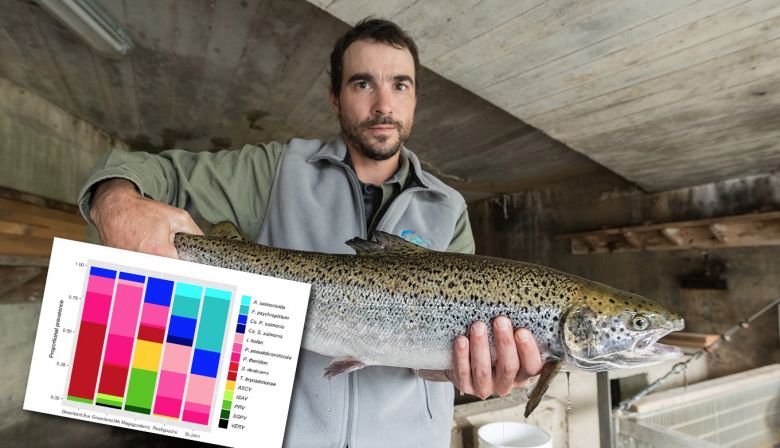
Subscribe & stay up-to-date with ASF

For Immediate Release
Apr. 28, 2020
ST. ANDREWS – Analysis of tissue samples from 150 Atlantic salmon has given scientists a first look at the viruses, bacteria, and microparasites that are infecting wild and aquaculture-origin Atlantic salmon in Eastern Canada and at sea. The findings were published this month in the peer-reviewed journal Facets and document the detection of 14 infectious agents, including five not previously described as occurring in the region.
The results confirmed that intercontinental transmission of infectious agents is likely occurring in offshore waters near Greenland between Atlantic salmon of North American and European origin. Analysis also showed that among the groups analyzed, aquaculture escapees had the highest prevalence of viruses and multiple infections were common among both cultured and wild fish.
Tissue samples were collected in 2016 and 2017 from Atlantic salmon at five different sites: two in New Brunswick, one in Quebec, and two in Greenland. The New Brunswick sites included aquaculture escapees removed from the Magaguadavic River and wild and hatchery origin salmon from the nearby St. John River. In Quebec, fishermen at Listuguj First Nation on the Restigouche River provided wild origin samples from their fishery, while in Greenland, samples from North American and European origin salmon were collected from traditional food markets in the communities of Paamiut and Maniitsoq.
All samples were sent to ASF headquarters in Chamcook, N.B. and then shipped to the DFO Pacific Biological Station in Nanaimo B.C. for molecular analysis to determine the presence or absence of 44 infectious agents known to cause disease in salmon worldwide.
Wild Atlantic salmon from more than 2,000 rivers in North America and Europe mix while feeding in the Labrador Sea and coastal waters off west Greenland. Results from the study showed that five infectious agents, including a “wild type” piscine orthoreovirus (PRV-1) originating from and carried by European origin salmon was found with nearly identical sequence in a North American origin salmon, supporting the hypothesis that viruses are shared among populations congregating in the area. A non-virulent strain of infectious salmon anemia virus (ISAV) was also detected in North American origin fish at sea.
Samples collected from returning adults in the St. John and Restigouche showed a high degree of infectious agent similarity. For example, St. John River salmon, an endangered population where individuals were non-lethally sampled by clipping a small fragment of gill tissue, had six different infectious agents. All of those, plus two additional agents, were found in the Restigouche fish, which had gill, heart, and kidney tissue examined.
Neither PRV nor ISAV was detected in the St. John and Restigouche sampled adults and proximity to open net-pen aquaculture sites was not found to have an influence on infection profiles.
Aquaculture escapees removed from the Magaguadavic River had a unique infection profile compared to other sampled groups. Seventy-six percent of the escapees sampled carried a PRV strain that differed from Greenland samples and instead resembled one from a Nova Scotia aquaculture fish.
Viral coinfection was common among the aquaculture escapees. For example, almost all PRV positive individuals were also infected with Atlantic salmon calicivirus (ASCV), an infectious agent often found with other viral agents like PRV in Norway. Salmon gill pox virus was found in two aquaculture escapees, both also carrying PRV and ASCV. These viral coinfections warrant further study to understand how they affect salmon health.
Although viruses like PRV-1 have been known to exist in the Eastern Canadian aquaculture industry, this is the first time that the full genome of the virus has been sequenced in this region.
Infectious agents can have profound effects on the health of host species, especially in poor conditions, like warm water. However, little is known about the current and potential role of disease in the decline of wild Atlantic salmon.
This novel analysis of viruses, bacteria, and microparasites affecting Atlantic salmon in Eastern Canada provides a baseline and has identified several opportunities for future research on pathogen transmission among wild and aquaculture salmon and between European and North American populations at sea.
-30-
Quotes:
“Atlantic salmon are one of the most studied fish in the world. Yet, until recently, scientists have not had the tools to assess the full array of infectious agents wild fish carry. This information is useful because poor environmental conditions, like warm water, can decrease the ability of salmon to keep infections under control and resist disease. These results open the door to a new wave of research on salmon health in the Atlantic Ocean.” – Amy Teffer, University of British Columbia
“Aquaculture escapees carried the most viruses of any group we studied and frequently had multiple infectious agents present. Our study looked at returning adult wild salmon, the survivors, so we weren’t able to see how out migrating smolt were affected as they passed near sea-cages in a critically vulnerable period of their life. This type of research will help us better understand the disease risks where wild and industrial fish overlap.” – Jonathan Carr, V.P. Research and Environment, Atlantic Salmon Federation
“Advanced DNA detection has completely changed the way we assess and address disease in marine animals like salmon. What was once untraceable is now trackable. Confirming that infectious agents move between European and North American salmon at Greenland shows the complexity of transmission in the wild, and the finding of similarities between PRV strains detected in east coast aquaculture salmon and fish in B.C. points to the unwitting effect humans can have on animal health.” – Kristina Miller, Fisheries and Oceans Canada, Pacific Biological Station
To arrange interviews contact:
Neville Crabbe, ASF
(506) 467-6804 ncrabbe@asf.ca
Backgrounder on viruses, bacteria, & parasites detected
Graph showing proportional prevalence of infectious agents
Image for use: Study author Amy Teffer, University of British Columbia